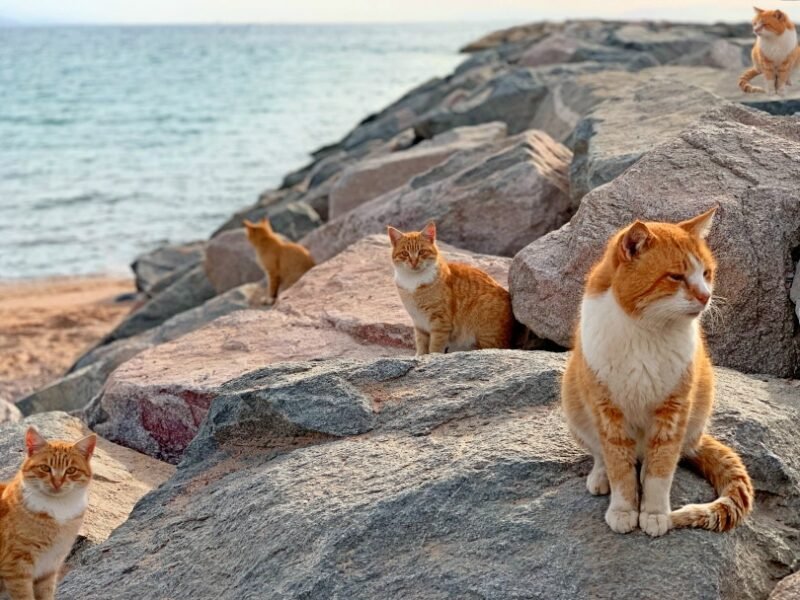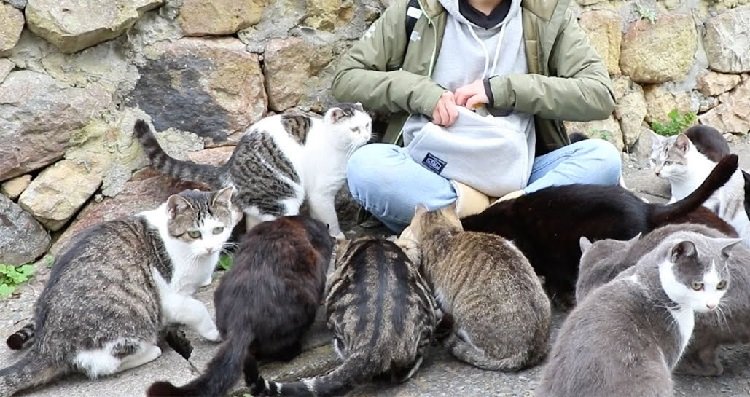Step into the feline fascination and embark on a journey to uncover the purrfect answer to the burning question: How many cats are in the world? Brace yourself for some awe-inspiring figures and astonishing facts as we delve into the mysterious world of our favorite four-legged companions. From the regal Maine Coons to the sleek Siamese, let’s explore the vast population of these enchanting creatures and get ready to be whiskered away by their captivating allure. So grab a cup of tea, find a snuggly spot, and prepare to have your cat-loving heart captivated by the sheer magnitude of these whiskered wonders.
The Science of Estimating Cat Populations
Estimating cat populations may sound like a straightforward task, but it is actually a complex and scientific process. Various methods and techniques are utilized to arrive at an accurate estimate, taking into account factors such as geographical location, domestication status, and the presence of feral cat populations. Let’s delve into the various methods used to estimate cat populations, the challenges faced in achieving an accurate estimate, and why scientists and researchers bother with such estimations.
The Various Methods Used to Estimate Cat Populations
Researchers employ a range of techniques to estimate cat populations, each with its own advantages and limitations. One commonly used method is direct observation, where researchers physically count the number of cats in a given area. This method is time-consuming and can be challenging, especially when dealing with feral cats that are elusive by nature.
Another method is known as mark and recapture, commonly used in ecological studies. This involves capturing a number of cats, marking them in a way that is distinguishable, and then releasing them back into the population. After a certain period of time, a second capture is conducted, and the number of marked cats in the recapture is used to estimate the overall population size.
Other indirect methods include using remote sensing techniques such as camera traps or analyzing DNA samples to determine the presence and abundance of cats in a particular area. These methods allow researchers to collect data without directly interacting with the cats, making them less invasive and potentially more accurate.
The Challenges in Achieving an Accurate Estimate
Estimating cat populations is not without its challenges. One of the main difficulties faced by researchers is the ability to differentiate between domestic cats and feral cats. Domestic cats are owned pets and usually have access to food, shelter, and healthcare, making them easier to track and estimate. On the other hand, feral cats are stray cats that live in the wild and are often elusive, making it harder to obtain accurate population estimates.
Additionally, cats are notorious for their wandering nature, making it challenging to confine their population within a specific area for accurate counting. Cats can cover vast distances and may move between urban and rural areas, further complicating the estimation process.
Furthermore, financial and logistical constraints can restrict the scope and scale of cat population studies. Conducting comprehensive surveys or studies across larger regions or even globally requires substantial resources and cooperation from different organizations and governments.
Why Scientists and Researchers Bother with Such Estimations
The accurate estimation of cat populations is crucial for a multitude of reasons. Firstly, it provides valuable data that helps in understanding the overall health and well-being of cat populations. By monitoring population sizes and trends, scientists can identify potential issues such as overpopulation, which can lead to adverse effects on the environment, public health risks, and strain on animal shelters and rescue organizations.
Furthermore, estimating cat populations is essential for conservation purposes, especially in areas where cats pose a threat to native wildlife. Understanding the impact of cat populations on local ecosystems allows researchers and conservationists to develop strategies for mitigating these effects and preserving biodiversity.
In addition, cat population estimation plays a significant role in the development of policies and initiatives aimed at controlling and managing cat populations. This includes programs for spaying and neutering, trap-neuter-return (TNR) programs for feral cats, and adoption initiatives. Accurate estimations provide the foundation for evidence-based decision-making and resource allocation in addressing cat population issues.
Current Global Cat Population Estimate
Determining the exact global cat population is a challenging task. However, based on the latest estimates and available data, we can gain a reasonable understanding of the current cat population worldwide. Let’s explore what the latest estimates say, the factors that influence these numbers, and how this estimate compares to previous years.
What the Latest Estimates Say
As of the most recent estimates, the global cat population is believed to be around 600 million. It’s important to note that this figure is an approximation, as there are inherent difficulties in accurately counting and tracking cats on a global scale. This estimate takes into account both domestic cats and feral cats that exist in various regions and environments.
The Factors That Influence These Numbers
Several factors contribute to the fluctuation and variability in global cat population estimates. One significant factor is the varying cultural attitudes towards cat ownership and management practices across different countries and regions. In areas where cats are highly valued as pets and have access to proper care and veterinary services, the domestic cat population is likely to be higher. Conversely, regions with a higher prevalence of feral cat populations may impact the overall global cat population estimate.
Geographical and environmental factors also play a role in determining cat populations. Cats are adaptable creatures and can be found in diverse habitats, ranging from urban areas to rural landscapes. The availability of food sources, climate conditions, and interactions with other species can influence the distribution and abundance of cats in different regions.
How This Estimate Compares to Previous Years
Estimating cat populations over time allows researchers and policymakers to monitor trends and identify possible changes in population dynamics. While there is limited historical data on global cat populations, some studies suggest that the current estimate of 600 million cats is relatively consistent with earlier estimates.
However, it’s important to acknowledge that population numbers can fluctuate due to various factors such as natural disasters, disease outbreaks, and changes in human behavior. Ongoing research and monitoring are essential in capturing and understanding these changes to inform appropriate management strategies.

Cat Population by Continent
Cats have successfully established populations on every continent, adapting to various environments and living alongside humans. Let’s explore the approximate number of cats found in different continents and understand the variations in cat populations worldwide.
Number of Cats in Asia
Asia, with its vast and diverse landscapes, is home to a significant number of domestic and feral cats. While specific cat population estimates may vary across countries in this continent, it is believed that there are several hundred million cats in Asia. Countries such as China, India, and Japan have substantial cat populations due to their large human populations and the increasing popularity of cats as pets.
Number of Cats in America
In North and South America, cats have established themselves as beloved companions to many households. The estimated cat population in the Americas exceeds 300 million. The United States alone is home to an estimated 94 million pet cats, making it one of the countries with the highest cat ownership rates globally. Additionally, feral cat populations pose significant challenges, particularly in regions where spaying and neutering programs are not widely implemented.
Number of Cats in Europe
Europe encompasses a diverse range of cultures and landscapes, with variations in cat populations across different countries. It is estimated that there are over 110 million cats in Europe, with countries such as Germany, France, and the United Kingdom having large cat populations. European countries often have well-established veterinary care and adoption programs, contributing to the overall health and well-being of domestic cats.
Number of Cats in Africa
Africa, known for its rich biodiversity and diverse ecosystems, is also home to a considerable number of cats. While accurate estimates are challenging due to the continent’s vastness and remote regions, it is believed that there are millions of cats in Africa. Countries such as Egypt, Morocco, and South Africa have notable domestic cat populations, with feral cat populations also present in some areas.
Number of Cats in Australia
Australia, with its unique wildlife and landscape, also has a substantial cat population. While specific estimates may vary, it is believed that there are around 5 to 6 million pet cats in Australia. However, feral cats pose a significant threat to native wildlife in the country, and efforts are being made to control their populations through programs such as TNR and conservation initiatives.
Impact of Cat Population on the Environment
The presence of cat populations, both domestic and feral, can have significant impacts on the environment. Their hunting instincts and interactions with other species can disrupt ecosystems and threaten biodiversity. Let’s explore the environmental effects of feral cats and how domestic cats can impact the environment, as well as the efforts being made to minimize these impacts.
Environmental Effect of Feral Cats
Feral cats, which are descendants of domestic cats that have returned to the wild, can pose a threat to native wildlife. These cats typically survive by hunting and have been responsible for the decline or extinction of numerous bird, mammal, and reptile species in various regions. Their predatory nature, particularly on small mammals and birds, disrupts the natural balance of ecosystems and can have cascading effects on other species.
Efforts to control feral cat populations through TNR programs and targeted removals are essential in mitigating their environmental impact. These strategies aim to reduce the number of feral cats and prevent further damage to native wildlife.
How Domestic Cats Impact the Environment
While domestic cats generally have access to food and care provided by their owners, they can still impact the environment in several ways. One significant issue is the predation of small mammals and birds, particularly when cats are allowed to roam freely outdoors. Even well-fed domestic cats can engage in hunting behaviors, as it is innate to their nature.
Additionally, cats can contribute to the spread of certain diseases and parasites that can affect other animals and humans. For example, Toxoplasma gondii, a protozoan parasite found in cat feces, can infect other animals and cause health issues.
Efforts to Minimize the Environmental Impact of Cats
Recognizing the environmental challenges posed by cat populations, various initiatives are being implemented to minimize their impact. One crucial approach is responsible pet ownership, which includes keeping cats indoors or providing them with enclosed outdoor spaces to prevent hunting. By limiting their access to wildlife, domestic cats can coexist more harmoniously with the environment.
Education and awareness campaigns are also vital, promoting the importance of responsible cat ownership and emphasizing the significance of keeping cats indoors to protect both wildlife and the cats themselves. Collaboration between environmental organizations, government agencies, and animal welfare groups is necessary to implement effective strategies that target both feral and domestic cat populations.

Breakdown of Domestic Cats vs. Feral Cats
Distinguishing between domestic cats and feral cats is essential for understanding population dynamics, implementing appropriate management strategies, and addressing the challenges associated with cat populations. Let’s examine the definition and identification of domestic and feral cats, the estimation of their populations, and the factors contributing to the number of feral cats.
Definition and Identification of Domestic and Feral Cats
Domestic cats are cats that have been selectively bred for companionship and have a history of living with humans. They are typically reliant on humans for food, shelter, and care. Domestic cats are more predictable in their behavior and can easily adapt to indoor living.
On the other hand, feral cats are unsocialized cats that have reverted to a wild state. They are generally wary of humans and can survive independently without human intervention. Feral cats often live in colonies, forming social groups for increased safety and opportunities to reproduce.
Differentiating between domestic and feral cats can be challenging, as some cats may exhibit behaviors similar to feral cats even if they were once domesticated. Observing their interactions with humans and determining their level of socialization is crucial in distinguishing between the two groups.
Estimation of Domestic and Feral Cat Populations
Estimating the number of domestic and feral cats is a complex process that involves a combination of direct observations, surveys, and statistical modeling. For domestic cats, data can be gathered through pet registration databases, veterinary records, and household surveys. However, it is important to note that these sources may not capture the entire population, as not all cats are registered or receive veterinary care.
Estimating feral cat populations is more challenging due to their elusive nature. Researchers often rely on indirect methods such as mark and recapture studies or remote sensing techniques. These methods provide an estimate of the proportion of marked cats within captured samples, which can then be used to extrapolate the overall feral cat population in a given area.
Factors That Contribute to the Number of Feral Cats
Several factors contribute to the number of feral cats in a particular area. One significant factor is the presence of unaltered and abandoned domestic cats that can breed and produce offspring that may eventually become feral. Lack of access to spaying and neutering services, as well as inadequate pet owner education and responsible ownership practices, can contribute to the overpopulation of feral cats.
Feral cat populations can also be influenced by the availability of food sources, shelter, and favorable environments. Areas with high rates of stray and feral cat populations often reflect a lack of management practices and resources to address these issues effectively.
Issues Arising From Overpopulation of Cats
The overpopulation of cats, both domestic and feral, can have far-reaching consequences. From the impact on native wildlife to the strain on animal shelters and public health risks, let’s explore the issues that arise as a result of cat overpopulation.
Effects on Native Wildlife
One of the significant concerns arising from cat overpopulation is the predation of native wildlife. Cats, driven by their hunting instincts, can devastate local bird populations, small mammals, reptiles, and amphibians. This predatory pressure can lead to imbalances in ecosystems, potentially threatening the survival of certain species and disrupting biodiversity.
Cat overpopulation exacerbates these effects, as larger populations of cats result in higher predation rates and increased competition for resources. The preservation of native wildlife and the delicate balance of ecosystems require effective strategies to manage cat populations and mitigate their impact on local fauna.
Overburdened Animal Shelters and Rescue Organizations
Cat overpopulation places a significant burden on animal shelters and rescue organizations. The number of cats in need of housing, care, and potential adoption often exceeds the available resources and capacity of these organizations. This results in overcrowded shelters, limited resources for medical care, and an increased risk of euthanasia for cats that are not adopted.
The strain on animal shelters also affects the overall well-being and health of cats, as overcrowding can lead to stress, the spread of diseases, and behavioral issues. Effective strategies to control cat overpopulation, such as spaying and neutering initiatives, are crucial in reducing the number of cats entering animal shelters and alleviating the strain on rescue organizations.
Public Health Risks Associated with Cat Overpopulation
Cat overpopulation can pose several public health risks. Cats that are not adequately cared for or receive regular veterinary care may carry diseases and parasites that can be transmitted to humans. Examples include toxoplasmosis, cat scratch disease, and transmission of certain zoonotic parasites, such as fleas and ticks.
Additionally, an abundance of feral cats in urban areas can lead to unsanitary conditions and the accumulation of cat waste, which can contribute to environmental contamination. Controlling cat populations through responsible ownership practices and effective management strategies is vital in minimizing public health risks associated with cat overpopulation.

Efforts to Control Cat Population
Recognizing the importance of controlling cat populations for both environmental and public health reasons, various initiatives and strategies have been implemented to manage cat populations effectively. Let’s explore the importance of spaying and neutering, trap-neuter-return (TNR) programs for feral cats, and adoption initiatives in achieving this goal.
The Importance of Spaying and Neutering
Spaying and neutering, also referred to as sterilization, play a pivotal role in controlling cat populations. These procedures involve the surgical removal of reproductive organs in cats, preventing them from reproducing. Spaying is performed on female cats by removing the ovaries and uterus, whereas neutering is the castration of male cats by removing the testicles.
Spaying and neutering not only reduce the likelihood of unwanted pregnancies but also offer several health benefits for cats, including a reduced risk of certain cancers and behavioral issues. By promoting and providing accessible spay/neuter services, cat populations can be effectively controlled, minimizing the strain on animal shelters and reducing the impact on the environment.
Trap-Neuter-Return Programs for Feral Cats
Trap-neuter-return (TNR) programs have gained prominence as a humane and effective approach to managing feral cat populations. TNR programs involve trapping feral cats, sterilizing them, providing necessary veterinary care, and then returning them to their original habitat. This approach prevents further breeding, stabilizes population sizes, and reduces the negative impacts on ecosystems and native wildlife.
TNR programs also include the establishment of managed colonies, where volunteers provide ongoing care, food, and shelter for the sterilized feral cats. These initiatives emphasize long-term sustainability by addressing the needs of feral cats while managing their population growth.
Adoption Initiatives and Influences on Cat Population
Promoting cat adoption is another crucial aspect of controlling cat populations. By encouraging the adoption of cats from shelters and rescue organizations, the demand for bred kittens and uncontrolled breeding decreases. Adoption initiatives often include awareness campaigns, reduced adoption fees, and providing information on responsible cat ownership.
Additionally, educational programs targeting potential cat owners help emphasize the responsibilities and commitment required in providing proper care for cats, including spaying and neutering. Encouraging adoption and responsible ownership contributes to population control efforts and reduces the number of cats in need of shelter and care.
Role of Cat Breeding in Cat Population
While efforts to control cat populations focus on managing stray, feral, and uncontrolled breeding, the role of cat breeding must also be considered. Cat breeding practices impact the overall cat population and influence the availability of specific cat breeds. Let’s explore how breeders affect the overall cat population, popular cat breeds and their populations, and controversial issues surrounding cat breeding.
How Breeders Affect the Overall Cat Population
Cat breeders play a significant role in shaping the overall cat population by selectively breeding cats to produce specific traits and characteristics. Breeders contribute to the availability of various cat breeds, each with its distinctive appearance, temperament, and health considerations. Ethical and responsible breeding practices prioritize the health and well-being of the cats and aim to preserve the integrity of specific breeds.
Breeding programs also influence population numbers, as intentional breeding helps sustain breed populations while managing population sizes responsibly. Responsible breeders prioritize genetic diversity and work towards minimizing health issues that may be associated with certain breeds.
Popular Cat Breeds and Their Population
Numerous cat breeds have gained popularity worldwide, attracting cat enthusiasts with their unique features and personalities. Some of the most popular cat breeds include the Persian, Maine Coon, Siamese, Bengal, and Scottish Fold. The population of these breeds can vary based on factors such as breed popularity, breeders’ availability, and specific breed characteristics that appeal to potential cat owners.
Population numbers for specific cat breeds may be influenced by a range of factors, including breeding practices, demand, and popularity trends. Breed-specific rescue organizations and adoption initiatives also contribute to the overall population numbers for specific breeds.
Controversial Issues Surrounding Cat Breeding
While cat breeding fulfills the demand for specific breeds and contributes to the diversity and preservation of feline lineages, it is not without its controversies. Concerns arise when breeding practices prioritize certain aesthetic traits over health and well-being, leading to potential genetic disorders or predispositions to certain health issues.
Additionally, the popularity of specific breeds can lead to increased demand, which, in turn, may drive unethical breeding practices, including the exploitation of cats for profit. It is crucial for cat breeders and the wider community to engage in responsible breeding practices, prioritize ethical considerations, and promote the health and welfare of the cats.

Cats as Companions: Trends in Cat Ownership
Cats have long been cherished as beloved companions, providing comfort, companionship, and entertainment to millions of people worldwide. Understanding the trends in cat ownership allows us to explore the factors that influence decisions to get a cat and how these trends impact the overall cat population.
Recent Statistics on Cat Ownership
Recent statistics indicate that cat ownership continues to be popular globally, with millions of households welcoming cats into their lives. The American Pet Products Association (APPA) estimates that in the United States alone, approximately 42.7 million households own a cat, accounting for over 95 million pet cats.
Similar trends can be observed in other countries, reflecting the enduring bond between humans and cats. Factors such as companionship, ease of care, and the unique personalities of cats contribute to their popularity as pets.
The Factors That Influence Decisions to Get a Cat
Several factors influence the decision to get a cat as a companion. One significant factor is the desire for companionship and the emotional benefits associated with pet ownership. Cats are known for their independent yet affectionate nature, providing comfort and companionship to individuals and families.
Lifestyle considerations also play a role in the decision to get a cat. Cats are generally lower maintenance compared to some other pets, making them suitable for individuals with busy schedules or limited living spaces. The appeal of a smaller pet that can thrive in an indoor environment further contributes to their popularity.
How Cat Ownership Trends Impact the Total Cat Population
Cat ownership trends have a direct impact on the total cat population, as the demand for cats influences breeding practices and population numbers. Increased interest in cat ownership can drive the popularity of specific breeds, resulting in more intentional breeding to meet the demand.
However, it is important to note that responsible breeding practices and adoption initiatives are crucial in maintaining a healthy and sustainable cat population. The availability of cats through adoption programs and responsible ownership practices can help control and manage population growth while addressing the needs of cats in need of homes.
Future Prediction of Global Cat Population
Predicting the future cat population at a global scale is a challenging task due to various factors that can influence population dynamics. However, understanding the factors that could potentially impact future cat populations, predicting trends, and considering potential impacts can provide insights into what lies ahead.
Factors That Could Influence Future Cat Population
Several factors could influence the future cat population globally. One significant factor is human population growth and urbanization trends. As more people inhabit urban areas, the demand for companion animals, including cats, is likely to increase. This could result in larger cat populations in urban environments and potential challenges in managing their impact.
Additionally, changes in cultural attitudes towards pet ownership and animal welfare can influence population numbers. Increased awareness and education about responsible cat ownership practices, including spaying and neutering, can contribute to controlled population growth as individuals become more conscious of the need for population management.
Predicted Trends in Cat Population
While precise predictions are challenging, some trends can be anticipated based on historical data and evolving societal factors. It is likely that the global cat population will continue to grow, driven by increasing demand for cats as companions. However, the rate of population growth may vary across different regions, influenced by cultural factors, economic conditions, and effective population control strategies.
Efforts to manage population growth, increased accessibility to spay/neuter services, and responsible ownership practices can help stabilize the growth and prevent the negative impacts associated with overpopulation. Collaboration between governments, relevant organizations, and the public in implementing and supporting population control initiatives is crucial for managing future cat populations effectively.
Potential Impacts of These Changes
The changes in global cat population trends and dynamics can have several potential impacts. The demand for cats as companions may result in increased efforts to meet that demand through responsible breeding practices and effective population management programs.
However, it is crucial to ensure that these changes are accompanied by ethical considerations and responsible ownership practices. Balancing the desire for specific cat breeds with the welfare and health of individual cats is essential in preserving the well-being of feline populations worldwide.
Furthermore, managing cat population growth is important in minimizing the environmental impact, preserving biodiversity, and protecting native wildlife. By addressing these potential impacts proactively through education, awareness, and effective management strategies, we can strive for a future where cats and other species coexist harmoniously.
In conclusion, estimating cat populations is a complex and scientific endeavor. From the methods used to estimate populations to the challenges faced in achieving accurate estimates, scientists and researchers invest time and resources to gather the data necessary for informed decision-making. The global cat population estimate stands at around 600 million cats, with variations across continents and regions. Cat populations, both domestic and feral, have significant implications for the environment, wildlife, public health, and animal welfare. Efforts to control cat populations are essential in minimizing these impacts, including spaying and neutering initiatives, TNR programs, adoption campaigns, and responsible breeding practices. With responsible ownership and proactive management strategies, we can ensure the well-being of cats, protect the environment, and maintain a harmonious relationship between humans and our feline companions.

